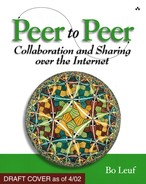Chapter 2. Peer Architectures
With a clearer grasp of what the p2p concept means, we can now take on the task of classifying peer architectures. This analysis is fairly abstract and non-specific, at least to begin with, because any subsequent discussions of specific technologies and implementations must build on a common groundwork.
As a first step, we must define the fundamental terms and the basic p2p models. Including a summary of primary characteristics in this overview proves useful when comparing the functionality of different technologies, and also when we look in Part III at the future development of p2p applications.
We also need to discuss protocols, the “glue” that holds networks together. Later chapters dissect particular protocols in considerable detail, so this discussion is not made dependent on any particular implementation. It provides a familiar context in which to place the later specifics. In addition, it can serve as a map to help identify any omissions or simplifications in the protocol design of a particular implementation, which could otherwise be obscured in the mass of technical detail.
Finally, because the focus of the book is mainly from the end user perspective, and thus on application implementations where the p2p software is entirely or mostly administered by the user, this chapter is the appropriate place to summarize some of the peer implementations that aren’t covered in other chapters. The final section therefore mentions a selection of common peer networking technologies native to different operating systems. These technologies often form the underlying transport layer in host systems that application p2p implementations depend on, yet transcend with their own protocols.
